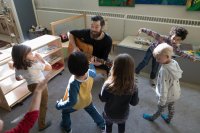Fun Music Lessons for Elementary Students
You only need to know a little bit about music to begin teaching your students to read notes and make music—no instruments required.
Your content has been saved!
Go to My Saved Content.“I just don’t know where to start!” is usually the response I get when I ask educators how confident they feel teaching music.
Despite continued cuts to the arts across the curriculum, schools are doing their very best to think of innovative ways to ensure that our children experience the fundamental lessons that can be learned through the expressive arts, but music is arguably the hardest subject to teach for a teacher who didn’t grow up playing an instrument. As many musicians say, music isn’t something you learn to play—it’s something you learn to feel.
Instructions for crafts can be found on Pinterest, artwork replicated from Instagram, and dance moves conveyed to students with YouTube videos—all of which can feed into the listening and talking skills children are developing. Add in the imaginative play children do during breaks and recess, which is a form of drama.
But then there is music. There’s a lot of value in having young kids sing along to alphabet songs and older ones rap the times tables. However, in order to develop a true understanding of musical structure and rhythm, teachers need to provide their students with much more depth in the study of music.
If the thought of teaching music sends shivers down your spine, here are a few lesson ideas that should help.
Lesson 1: Beatboxing
Teaching pupils to beatbox will develop their musical counting ability while also teaching them about timbre and rhythm. A basic beatbox pattern is: b t k t, where the b replicates the bass drum, t sounds like the hi-hat, and the k acts as a snappy-sounding snare drum.
If you’re totally unfamiliar with teaching music, a vital thing to be aware of is that music is written in bars. Each bar has a set number of beats within it. You can begin with having students simply count in bars of 4 (one, two, three, four; one, two, three, four; one, two, etc). Once they have grasped the concept, you can begin to replace the numbers with the letters above. The ultimate goal is for students to move beyond producing the letter sounds and create the noises of a drum kit using mouth movements.
Once students have mastered this, lessons can be taken in a number of different directions: You can ask your students to make up their own beatbox patterns in bars of four, or create short poems in pairs and perform them—one student reciting and the other beatboxing—or even replace the sounds with body percussion movements for a more dynamic and active performance using the whole body (e.g., stamp, click fingers, clap, click fingers).
Lesson 2: Walking Music
This lesson can be taken outside on a sunny day for a change of scene. Draw seven parallel lines on the ground to create an eight-beat walkway that students can practice walking across in time to a strict tempo. You’ll need to think about the age and ability of your students, as this will determine the size of gap between each line and the speed at which you expect them to walk. When it comes to tempo, slower is better to start off—you can always speed it up later, but starting quickly and then having to slow down can be demoralizing to some students.
Once they can walk in time, you can use chalk to add words or beatbox sounds and create short but effective walking compositions. For example, using the letters from the beatboxing lesson, a k can represent a hand clap—when a student steps in a box where you have written a k, they clap their hands.
Lesson 3: Notation
Building on lesson 2, if you’re able to teach your students musical notation, you can create note trails that pupils can follow and play with their feet. Notation may seem intimidating, but you really only need to teach four pieces of notation to achieve some great musical results: half beat, single beat, double beat, and single pause are the terms I use to teach these to beginners.

Clapping out these beats while counting in bars of four, students should be able to quickly pick up the length that each note represents. Begin by clapping four single beats while counting the numbers 1 to 4 aloud. Then move to clapping two double beats while counting the numbers 1 to 4 aloud. Finally, clap eight half beats while counting the numbers 1 to 4 aloud. You can then challenge pupils to create their own four-beat bar of music using notation. They’ll soon realize that the total value of notes always has to add up to four (for example: half beat, half beat, double beat, single beat).
Ensuring that students work with bars of four beats will keep things easy and a constant rhythm can be established, thereby reducing cognitive load. Within the same lesson your class should be able to clap along to scores like this:

If you have a stairwell, you can transfer your lesson from the floor to the steps, with each step representing one beat. My class ended up turning a whole corridor into a musical walkway, with a trail of notes leading from the main entrance to the classroom door. It served as a fun way to prime students for learning.
